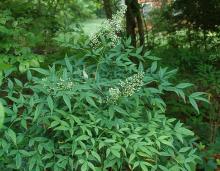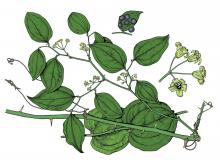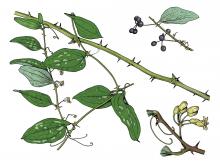Trees, Shrubs and Woody Vines
Media

Species Types
Scientific Name
Parthenocissus vitacea (syn. P. inserta)
Description
Woodbine is a climbing woody vine that usually sprawls over bushes and rocks. Its leaves have five coarsely toothed leaflets. Unlike the closely related Virginia creeper, its tendrils generally lack sucker disks. It is rarely found in Missouri.
Media

Species Types
Scientific Name
Cissus trifoliata (syn. C. incisa)
Description
Marine vine is a climbing or trailing woody vine to 30 feet high, climbing by tendrils. Uncommon in Missouri, it is found only in our far southwestern counties.
Media

Species Types
Scientific Name
Ceanothus americanus
Description
A very small shrub of our native prairies and other open sites, New Jersey tea was used by patriotic American colonists as a substitute for black tea imported from England during the Revolutionary War.
Media

Species Types
Scientific Name
Physocarpus opulifolius
Description
An attractive shrub with wide-spreading, graceful, recurved branches and bark peeling off in conspicuous thin strips, ninebark is found throughout southern and eastern Missouri on gravel bars, rocky stream banks, and bluffs along streams. It's very popular as a native landscaping shrub, too.
Media

Species Types
Scientific Name
Ribes americanum
Description
American black currant is uncommon in Missouri, known from only one location in Schuyler County. The leaves have orange, resinous glands on the undersurface. A spineless shrub, it bears flowers, and later black berries, in clusters of 6–15.
Media

Species Types
Scientific Name
Ribes missouriense
Description
Missouri gooseberry is our state’s most widespread and common gooseberry. People brave its prickly stems to collect its tart, tasty fruits to make pies, jams, and jellies.
Media

Species Types
Scientific Name
Nandina domestica
Description
Heavenly bamboo is hardly “heavenly” when it comes to its negative effects on our native plants and animals. A tremendously popular landscaping plant, it readily escapes and is difficult to eradicate.
Media

Species Types
Scientific Name
Smilax rotundifolia
Description
Round-leaved catbrier is a climbing, perennial woody vine to 20 feet long with tendrils and stout spines, sometimes forming tangled thickets. In Missouri, it is found mainly in the Bootheel and nearby southeastern Ozarks.
Media

Species Types
Scientific Name
Smilax hispida (syn. S. tamnoides var. hispida)
Description
Bristly greenbrier is a stout woody vine with bristlelike black spines, climbing high by tendrils to a length of 40 feet. It is the most common greenbrier in Missouri and is found statewide.
Media

Species Types
Scientific Name
Smilax glauca
Description
Greenbrier is a slender, spiny, woody vine climbing by coiled tendrils. Its leaves can be broadly heart-shaped, oval, or lance-shaped. The leaf undersurface is smooth and notably whitened, silvery, or blue-gray with a waxy coating.
See Also
About Trees, Shrubs and Woody Vines in Missouri
There are no sharp dividing lines between trees, shrubs, and woody vines, or even between woody and nonwoody plants. “Wood” is a type of tissue made of cellulose and lignin that many plants develop as they mature — whether they are “woody” or not. Trees are woody plants over 13 feet tall with a single trunk. Shrubs are less than 13 feet tall, with multiple stems. Vines require support or else sprawl over the ground.





















